Epidemiology of Salmonella Typhimurium: Causative Factors, Prevalence, and Preventive Measures
VerifiedAdded on 2023/06/05
|11
|3134
|350
AI Summary
This essay discusses the epidemiology of Salmonella Typhimurium, including its causative factors, prevalence, and preventive measures. It also covers the global impact of the disease and its various forms of infection. The essay highlights the severity of the disease, its impact on children, and the high rate of hospitalization. It also provides an overview of the disease's prevalence in New Zealand and the various outbreaks that have occurred in recent years.
Contribute Materials
Your contribution can guide someone’s learning journey. Share your
documents today.

Running head: EPIDEMIOLOGY IN SALMONELLA TYPHIMURIUM
Epidemiology in Salmonella Typhimurium
Name of the Student
Name of the University
Author Note
Epidemiology in Salmonella Typhimurium
Name of the Student
Name of the University
Author Note
Secure Best Marks with AI Grader
Need help grading? Try our AI Grader for instant feedback on your assignments.
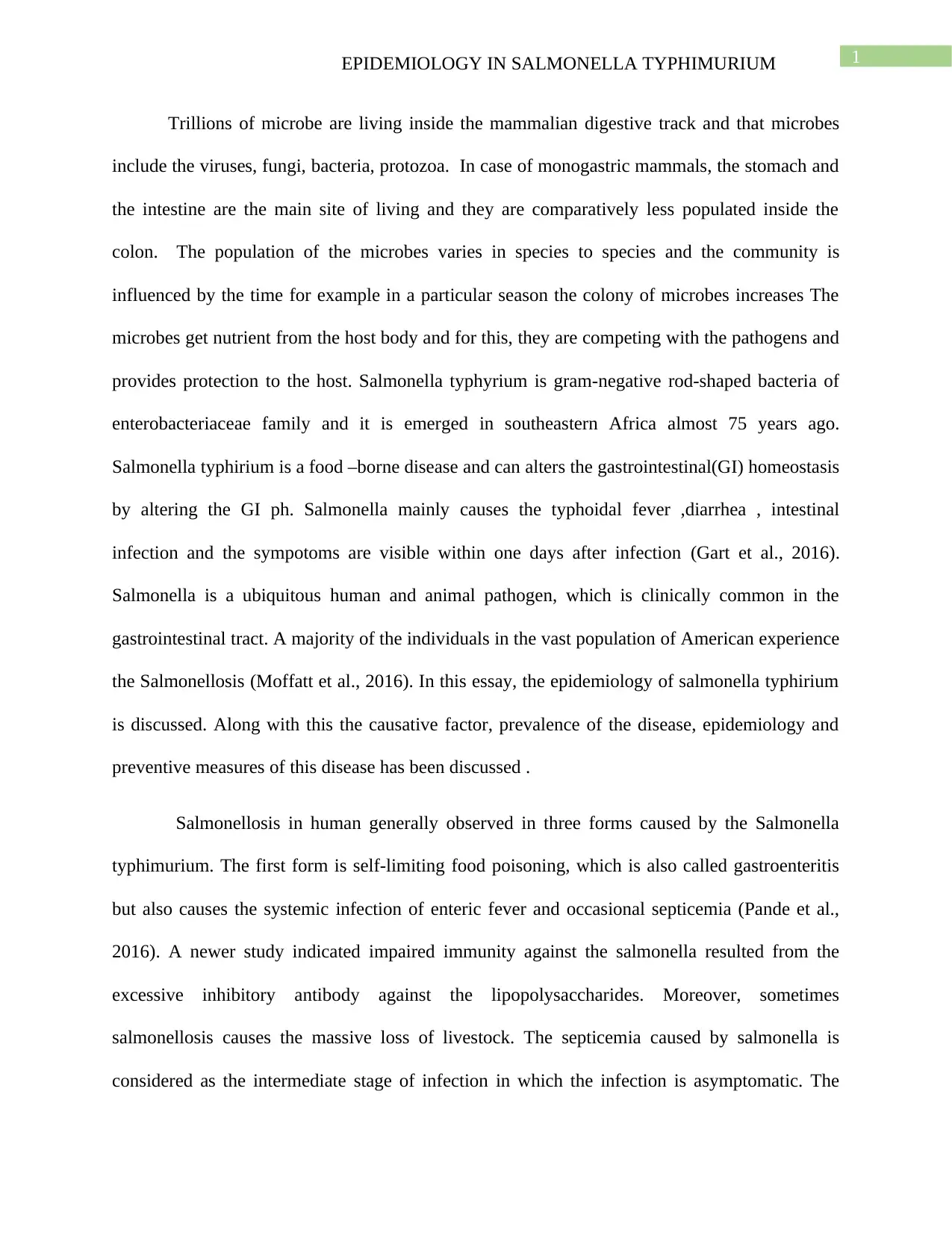
1EPIDEMIOLOGY IN SALMONELLA TYPHIMURIUM
Trillions of microbe are living inside the mammalian digestive track and that microbes
include the viruses, fungi, bacteria, protozoa. In case of monogastric mammals, the stomach and
the intestine are the main site of living and they are comparatively less populated inside the
colon. The population of the microbes varies in species to species and the community is
influenced by the time for example in a particular season the colony of microbes increases The
microbes get nutrient from the host body and for this, they are competing with the pathogens and
provides protection to the host. Salmonella typhyrium is gram-negative rod-shaped bacteria of
enterobacteriaceae family and it is emerged in southeastern Africa almost 75 years ago.
Salmonella typhirium is a food –borne disease and can alters the gastrointestinal(GI) homeostasis
by altering the GI ph. Salmonella mainly causes the typhoidal fever ,diarrhea , intestinal
infection and the sympotoms are visible within one days after infection (Gart et al., 2016).
Salmonella is a ubiquitous human and animal pathogen, which is clinically common in the
gastrointestinal tract. A majority of the individuals in the vast population of American experience
the Salmonellosis (Moffatt et al., 2016). In this essay, the epidemiology of salmonella typhirium
is discussed. Along with this the causative factor, prevalence of the disease, epidemiology and
preventive measures of this disease has been discussed .
Salmonellosis in human generally observed in three forms caused by the Salmonella
typhimurium. The first form is self-limiting food poisoning, which is also called gastroenteritis
but also causes the systemic infection of enteric fever and occasional septicemia (Pande et al.,
2016). A newer study indicated impaired immunity against the salmonella resulted from the
excessive inhibitory antibody against the lipopolysaccharides. Moreover, sometimes
salmonellosis causes the massive loss of livestock. The septicemia caused by salmonella is
considered as the intermediate stage of infection in which the infection is asymptomatic. The
Trillions of microbe are living inside the mammalian digestive track and that microbes
include the viruses, fungi, bacteria, protozoa. In case of monogastric mammals, the stomach and
the intestine are the main site of living and they are comparatively less populated inside the
colon. The population of the microbes varies in species to species and the community is
influenced by the time for example in a particular season the colony of microbes increases The
microbes get nutrient from the host body and for this, they are competing with the pathogens and
provides protection to the host. Salmonella typhyrium is gram-negative rod-shaped bacteria of
enterobacteriaceae family and it is emerged in southeastern Africa almost 75 years ago.
Salmonella typhirium is a food –borne disease and can alters the gastrointestinal(GI) homeostasis
by altering the GI ph. Salmonella mainly causes the typhoidal fever ,diarrhea , intestinal
infection and the sympotoms are visible within one days after infection (Gart et al., 2016).
Salmonella is a ubiquitous human and animal pathogen, which is clinically common in the
gastrointestinal tract. A majority of the individuals in the vast population of American experience
the Salmonellosis (Moffatt et al., 2016). In this essay, the epidemiology of salmonella typhirium
is discussed. Along with this the causative factor, prevalence of the disease, epidemiology and
preventive measures of this disease has been discussed .
Salmonellosis in human generally observed in three forms caused by the Salmonella
typhimurium. The first form is self-limiting food poisoning, which is also called gastroenteritis
but also causes the systemic infection of enteric fever and occasional septicemia (Pande et al.,
2016). A newer study indicated impaired immunity against the salmonella resulted from the
excessive inhibitory antibody against the lipopolysaccharides. Moreover, sometimes
salmonellosis causes the massive loss of livestock. The septicemia caused by salmonella is
considered as the intermediate stage of infection in which the infection is asymptomatic. The
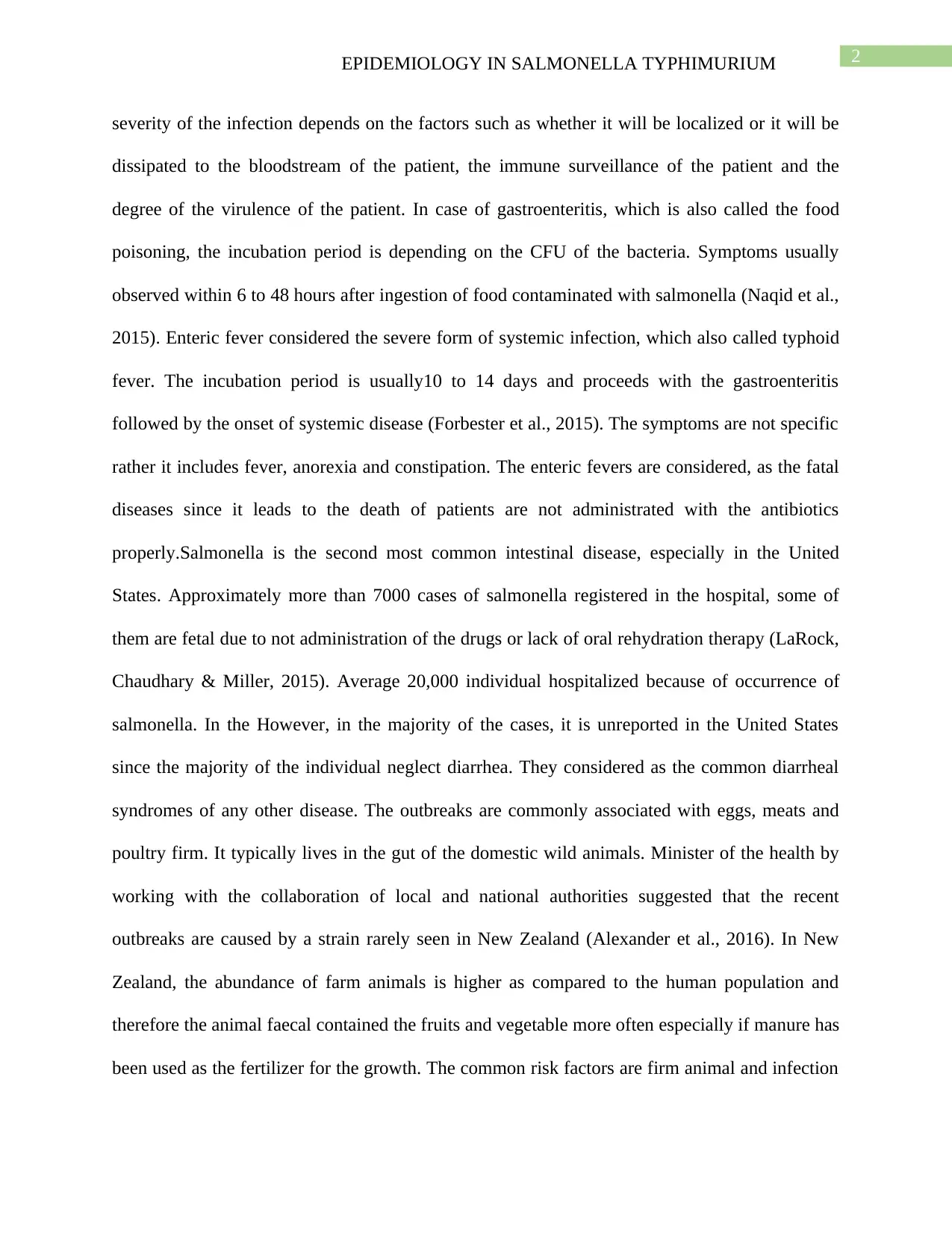
2EPIDEMIOLOGY IN SALMONELLA TYPHIMURIUM
severity of the infection depends on the factors such as whether it will be localized or it will be
dissipated to the bloodstream of the patient, the immune surveillance of the patient and the
degree of the virulence of the patient. In case of gastroenteritis, which is also called the food
poisoning, the incubation period is depending on the CFU of the bacteria. Symptoms usually
observed within 6 to 48 hours after ingestion of food contaminated with salmonella (Naqid et al.,
2015). Enteric fever considered the severe form of systemic infection, which also called typhoid
fever. The incubation period is usually10 to 14 days and proceeds with the gastroenteritis
followed by the onset of systemic disease (Forbester et al., 2015). The symptoms are not specific
rather it includes fever, anorexia and constipation. The enteric fevers are considered, as the fatal
diseases since it leads to the death of patients are not administrated with the antibiotics
properly.Salmonella is the second most common intestinal disease, especially in the United
States. Approximately more than 7000 cases of salmonella registered in the hospital, some of
them are fetal due to not administration of the drugs or lack of oral rehydration therapy (LaRock,
Chaudhary & Miller, 2015). Average 20,000 individual hospitalized because of occurrence of
salmonella. In the However, in the majority of the cases, it is unreported in the United States
since the majority of the individual neglect diarrhea. They considered as the common diarrheal
syndromes of any other disease. The outbreaks are commonly associated with eggs, meats and
poultry firm. It typically lives in the gut of the domestic wild animals. Minister of the health by
working with the collaboration of local and national authorities suggested that the recent
outbreaks are caused by a strain rarely seen in New Zealand (Alexander et al., 2016). In New
Zealand, the abundance of farm animals is higher as compared to the human population and
therefore the animal faecal contained the fruits and vegetable more often especially if manure has
been used as the fertilizer for the growth. The common risk factors are firm animal and infection
severity of the infection depends on the factors such as whether it will be localized or it will be
dissipated to the bloodstream of the patient, the immune surveillance of the patient and the
degree of the virulence of the patient. In case of gastroenteritis, which is also called the food
poisoning, the incubation period is depending on the CFU of the bacteria. Symptoms usually
observed within 6 to 48 hours after ingestion of food contaminated with salmonella (Naqid et al.,
2015). Enteric fever considered the severe form of systemic infection, which also called typhoid
fever. The incubation period is usually10 to 14 days and proceeds with the gastroenteritis
followed by the onset of systemic disease (Forbester et al., 2015). The symptoms are not specific
rather it includes fever, anorexia and constipation. The enteric fevers are considered, as the fatal
diseases since it leads to the death of patients are not administrated with the antibiotics
properly.Salmonella is the second most common intestinal disease, especially in the United
States. Approximately more than 7000 cases of salmonella registered in the hospital, some of
them are fetal due to not administration of the drugs or lack of oral rehydration therapy (LaRock,
Chaudhary & Miller, 2015). Average 20,000 individual hospitalized because of occurrence of
salmonella. In the However, in the majority of the cases, it is unreported in the United States
since the majority of the individual neglect diarrhea. They considered as the common diarrheal
syndromes of any other disease. The outbreaks are commonly associated with eggs, meats and
poultry firm. It typically lives in the gut of the domestic wild animals. Minister of the health by
working with the collaboration of local and national authorities suggested that the recent
outbreaks are caused by a strain rarely seen in New Zealand (Alexander et al., 2016). In New
Zealand, the abundance of farm animals is higher as compared to the human population and
therefore the animal faecal contained the fruits and vegetable more often especially if manure has
been used as the fertilizer for the growth. The common risk factors are firm animal and infection
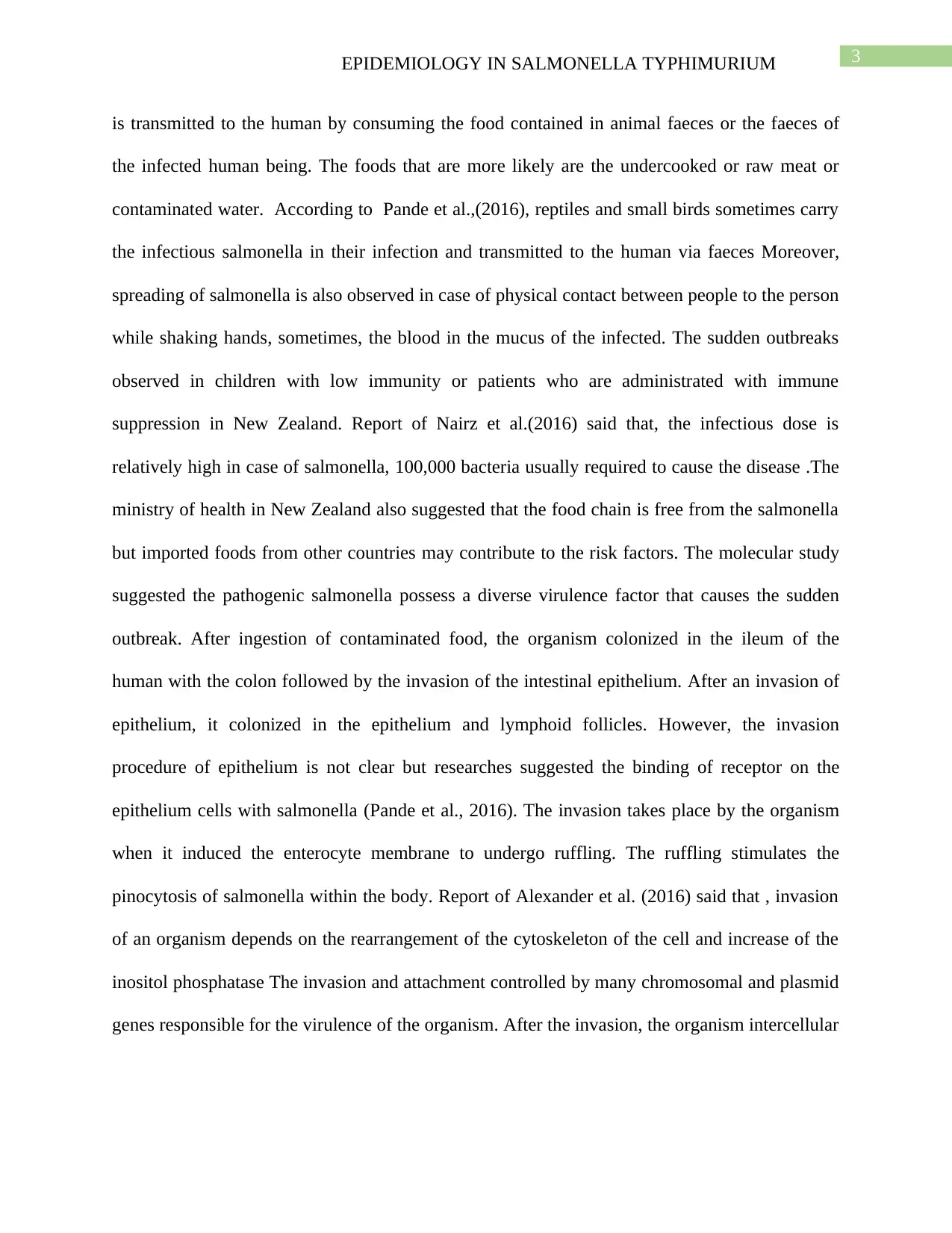
3EPIDEMIOLOGY IN SALMONELLA TYPHIMURIUM
is transmitted to the human by consuming the food contained in animal faeces or the faeces of
the infected human being. The foods that are more likely are the undercooked or raw meat or
contaminated water. According to Pande et al.,(2016), reptiles and small birds sometimes carry
the infectious salmonella in their infection and transmitted to the human via faeces Moreover,
spreading of salmonella is also observed in case of physical contact between people to the person
while shaking hands, sometimes, the blood in the mucus of the infected. The sudden outbreaks
observed in children with low immunity or patients who are administrated with immune
suppression in New Zealand. Report of Nairz et al.(2016) said that, the infectious dose is
relatively high in case of salmonella, 100,000 bacteria usually required to cause the disease .The
ministry of health in New Zealand also suggested that the food chain is free from the salmonella
but imported foods from other countries may contribute to the risk factors. The molecular study
suggested the pathogenic salmonella possess a diverse virulence factor that causes the sudden
outbreak. After ingestion of contaminated food, the organism colonized in the ileum of the
human with the colon followed by the invasion of the intestinal epithelium. After an invasion of
epithelium, it colonized in the epithelium and lymphoid follicles. However, the invasion
procedure of epithelium is not clear but researches suggested the binding of receptor on the
epithelium cells with salmonella (Pande et al., 2016). The invasion takes place by the organism
when it induced the enterocyte membrane to undergo ruffling. The ruffling stimulates the
pinocytosis of salmonella within the body. Report of Alexander et al. (2016) said that , invasion
of an organism depends on the rearrangement of the cytoskeleton of the cell and increase of the
inositol phosphatase The invasion and attachment controlled by many chromosomal and plasmid
genes responsible for the virulence of the organism. After the invasion, the organism intercellular
is transmitted to the human by consuming the food contained in animal faeces or the faeces of
the infected human being. The foods that are more likely are the undercooked or raw meat or
contaminated water. According to Pande et al.,(2016), reptiles and small birds sometimes carry
the infectious salmonella in their infection and transmitted to the human via faeces Moreover,
spreading of salmonella is also observed in case of physical contact between people to the person
while shaking hands, sometimes, the blood in the mucus of the infected. The sudden outbreaks
observed in children with low immunity or patients who are administrated with immune
suppression in New Zealand. Report of Nairz et al.(2016) said that, the infectious dose is
relatively high in case of salmonella, 100,000 bacteria usually required to cause the disease .The
ministry of health in New Zealand also suggested that the food chain is free from the salmonella
but imported foods from other countries may contribute to the risk factors. The molecular study
suggested the pathogenic salmonella possess a diverse virulence factor that causes the sudden
outbreak. After ingestion of contaminated food, the organism colonized in the ileum of the
human with the colon followed by the invasion of the intestinal epithelium. After an invasion of
epithelium, it colonized in the epithelium and lymphoid follicles. However, the invasion
procedure of epithelium is not clear but researches suggested the binding of receptor on the
epithelium cells with salmonella (Pande et al., 2016). The invasion takes place by the organism
when it induced the enterocyte membrane to undergo ruffling. The ruffling stimulates the
pinocytosis of salmonella within the body. Report of Alexander et al. (2016) said that , invasion
of an organism depends on the rearrangement of the cytoskeleton of the cell and increase of the
inositol phosphatase The invasion and attachment controlled by many chromosomal and plasmid
genes responsible for the virulence of the organism. After the invasion, the organism intercellular
Secure Best Marks with AI Grader
Need help grading? Try our AI Grader for instant feedback on your assignments.
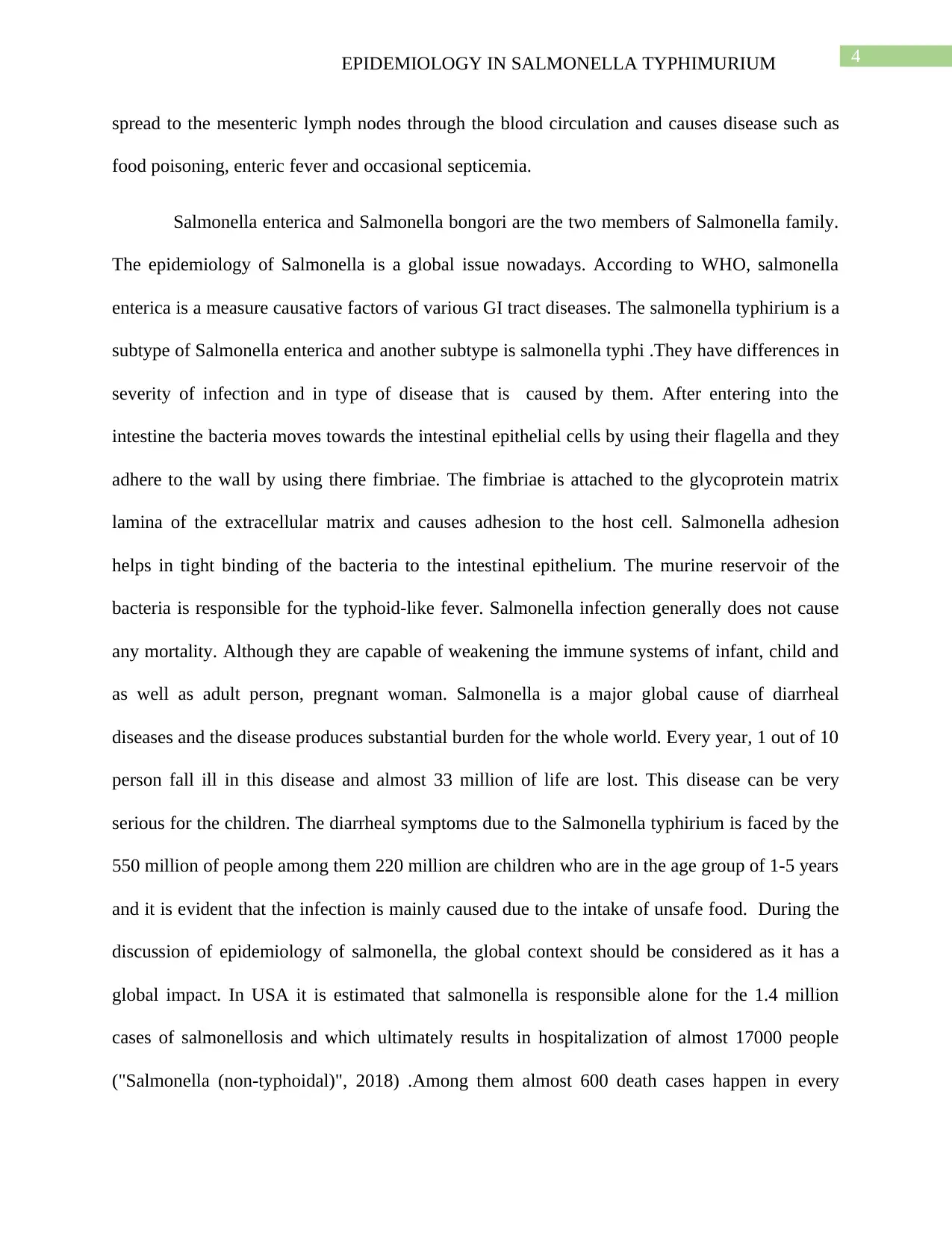
4EPIDEMIOLOGY IN SALMONELLA TYPHIMURIUM
spread to the mesenteric lymph nodes through the blood circulation and causes disease such as
food poisoning, enteric fever and occasional septicemia.
Salmonella enterica and Salmonella bongori are the two members of Salmonella family.
The epidemiology of Salmonella is a global issue nowadays. According to WHO, salmonella
enterica is a measure causative factors of various GI tract diseases. The salmonella typhirium is a
subtype of Salmonella enterica and another subtype is salmonella typhi .They have differences in
severity of infection and in type of disease that is caused by them. After entering into the
intestine the bacteria moves towards the intestinal epithelial cells by using their flagella and they
adhere to the wall by using there fimbriae. The fimbriae is attached to the glycoprotein matrix
lamina of the extracellular matrix and causes adhesion to the host cell. Salmonella adhesion
helps in tight binding of the bacteria to the intestinal epithelium. The murine reservoir of the
bacteria is responsible for the typhoid-like fever. Salmonella infection generally does not cause
any mortality. Although they are capable of weakening the immune systems of infant, child and
as well as adult person, pregnant woman. Salmonella is a major global cause of diarrheal
diseases and the disease produces substantial burden for the whole world. Every year, 1 out of 10
person fall ill in this disease and almost 33 million of life are lost. This disease can be very
serious for the children. The diarrheal symptoms due to the Salmonella typhirium is faced by the
550 million of people among them 220 million are children who are in the age group of 1-5 years
and it is evident that the infection is mainly caused due to the intake of unsafe food. During the
discussion of epidemiology of salmonella, the global context should be considered as it has a
global impact. In USA it is estimated that salmonella is responsible alone for the 1.4 million
cases of salmonellosis and which ultimately results in hospitalization of almost 17000 people
("Salmonella (non-typhoidal)", 2018) .Among them almost 600 death cases happen in every
spread to the mesenteric lymph nodes through the blood circulation and causes disease such as
food poisoning, enteric fever and occasional septicemia.
Salmonella enterica and Salmonella bongori are the two members of Salmonella family.
The epidemiology of Salmonella is a global issue nowadays. According to WHO, salmonella
enterica is a measure causative factors of various GI tract diseases. The salmonella typhirium is a
subtype of Salmonella enterica and another subtype is salmonella typhi .They have differences in
severity of infection and in type of disease that is caused by them. After entering into the
intestine the bacteria moves towards the intestinal epithelial cells by using their flagella and they
adhere to the wall by using there fimbriae. The fimbriae is attached to the glycoprotein matrix
lamina of the extracellular matrix and causes adhesion to the host cell. Salmonella adhesion
helps in tight binding of the bacteria to the intestinal epithelium. The murine reservoir of the
bacteria is responsible for the typhoid-like fever. Salmonella infection generally does not cause
any mortality. Although they are capable of weakening the immune systems of infant, child and
as well as adult person, pregnant woman. Salmonella is a major global cause of diarrheal
diseases and the disease produces substantial burden for the whole world. Every year, 1 out of 10
person fall ill in this disease and almost 33 million of life are lost. This disease can be very
serious for the children. The diarrheal symptoms due to the Salmonella typhirium is faced by the
550 million of people among them 220 million are children who are in the age group of 1-5 years
and it is evident that the infection is mainly caused due to the intake of unsafe food. During the
discussion of epidemiology of salmonella, the global context should be considered as it has a
global impact. In USA it is estimated that salmonella is responsible alone for the 1.4 million
cases of salmonellosis and which ultimately results in hospitalization of almost 17000 people
("Salmonella (non-typhoidal)", 2018) .Among them almost 600 death cases happen in every
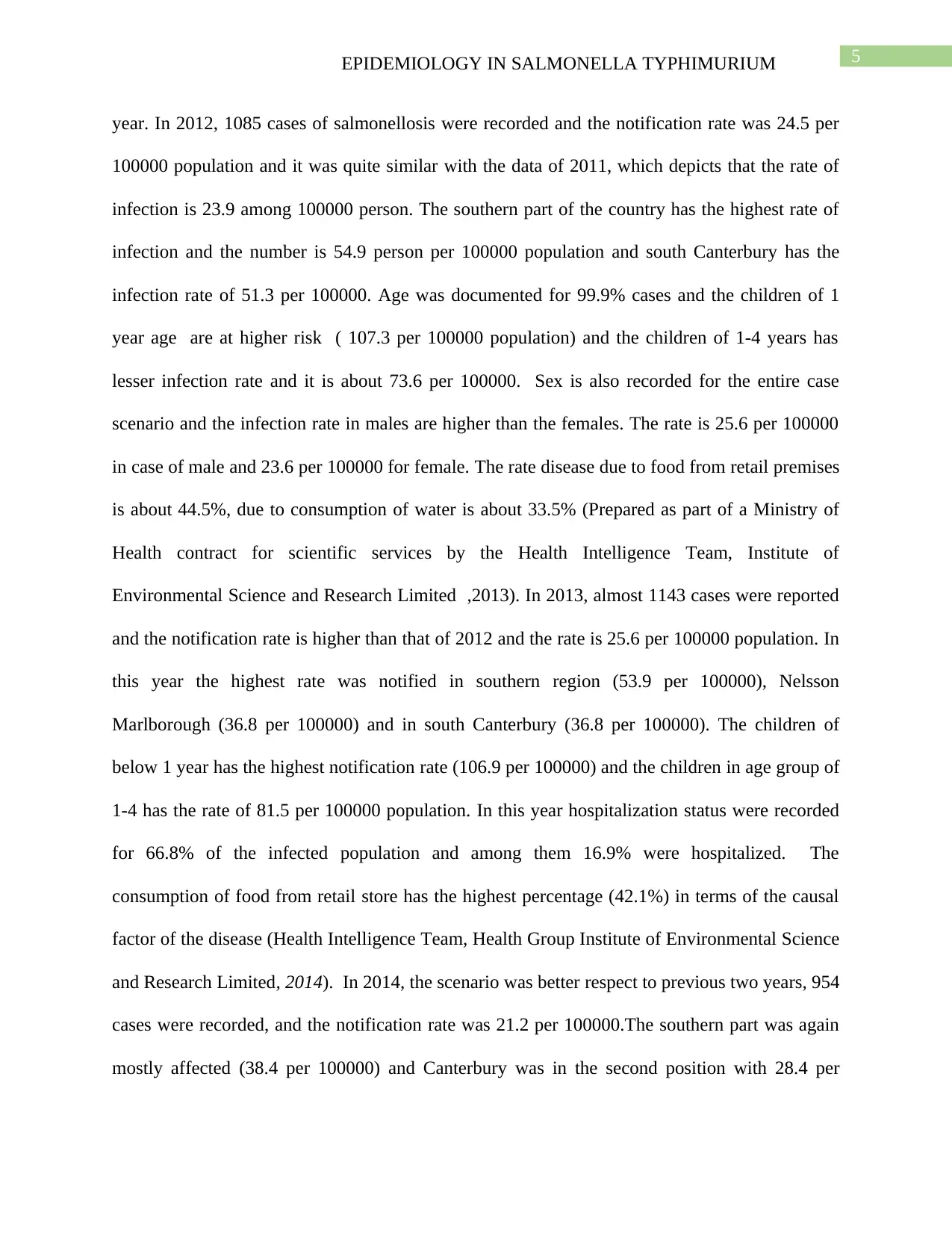
5EPIDEMIOLOGY IN SALMONELLA TYPHIMURIUM
year. In 2012, 1085 cases of salmonellosis were recorded and the notification rate was 24.5 per
100000 population and it was quite similar with the data of 2011, which depicts that the rate of
infection is 23.9 among 100000 person. The southern part of the country has the highest rate of
infection and the number is 54.9 person per 100000 population and south Canterbury has the
infection rate of 51.3 per 100000. Age was documented for 99.9% cases and the children of 1
year age are at higher risk ( 107.3 per 100000 population) and the children of 1-4 years has
lesser infection rate and it is about 73.6 per 100000. Sex is also recorded for the entire case
scenario and the infection rate in males are higher than the females. The rate is 25.6 per 100000
in case of male and 23.6 per 100000 for female. The rate disease due to food from retail premises
is about 44.5%, due to consumption of water is about 33.5% (Prepared as part of a Ministry of
Health contract for scientific services by the Health Intelligence Team, Institute of
Environmental Science and Research Limited ,2013). In 2013, almost 1143 cases were reported
and the notification rate is higher than that of 2012 and the rate is 25.6 per 100000 population. In
this year the highest rate was notified in southern region (53.9 per 100000), Nelsson
Marlborough (36.8 per 100000) and in south Canterbury (36.8 per 100000). The children of
below 1 year has the highest notification rate (106.9 per 100000) and the children in age group of
1-4 has the rate of 81.5 per 100000 population. In this year hospitalization status were recorded
for 66.8% of the infected population and among them 16.9% were hospitalized. The
consumption of food from retail store has the highest percentage (42.1%) in terms of the causal
factor of the disease (Health Intelligence Team, Health Group Institute of Environmental Science
and Research Limited, 2014). In 2014, the scenario was better respect to previous two years, 954
cases were recorded, and the notification rate was 21.2 per 100000.The southern part was again
mostly affected (38.4 per 100000) and Canterbury was in the second position with 28.4 per
year. In 2012, 1085 cases of salmonellosis were recorded and the notification rate was 24.5 per
100000 population and it was quite similar with the data of 2011, which depicts that the rate of
infection is 23.9 among 100000 person. The southern part of the country has the highest rate of
infection and the number is 54.9 person per 100000 population and south Canterbury has the
infection rate of 51.3 per 100000. Age was documented for 99.9% cases and the children of 1
year age are at higher risk ( 107.3 per 100000 population) and the children of 1-4 years has
lesser infection rate and it is about 73.6 per 100000. Sex is also recorded for the entire case
scenario and the infection rate in males are higher than the females. The rate is 25.6 per 100000
in case of male and 23.6 per 100000 for female. The rate disease due to food from retail premises
is about 44.5%, due to consumption of water is about 33.5% (Prepared as part of a Ministry of
Health contract for scientific services by the Health Intelligence Team, Institute of
Environmental Science and Research Limited ,2013). In 2013, almost 1143 cases were reported
and the notification rate is higher than that of 2012 and the rate is 25.6 per 100000 population. In
this year the highest rate was notified in southern region (53.9 per 100000), Nelsson
Marlborough (36.8 per 100000) and in south Canterbury (36.8 per 100000). The children of
below 1 year has the highest notification rate (106.9 per 100000) and the children in age group of
1-4 has the rate of 81.5 per 100000 population. In this year hospitalization status were recorded
for 66.8% of the infected population and among them 16.9% were hospitalized. The
consumption of food from retail store has the highest percentage (42.1%) in terms of the causal
factor of the disease (Health Intelligence Team, Health Group Institute of Environmental Science
and Research Limited, 2014). In 2014, the scenario was better respect to previous two years, 954
cases were recorded, and the notification rate was 21.2 per 100000.The southern part was again
mostly affected (38.4 per 100000) and Canterbury was in the second position with 28.4 per
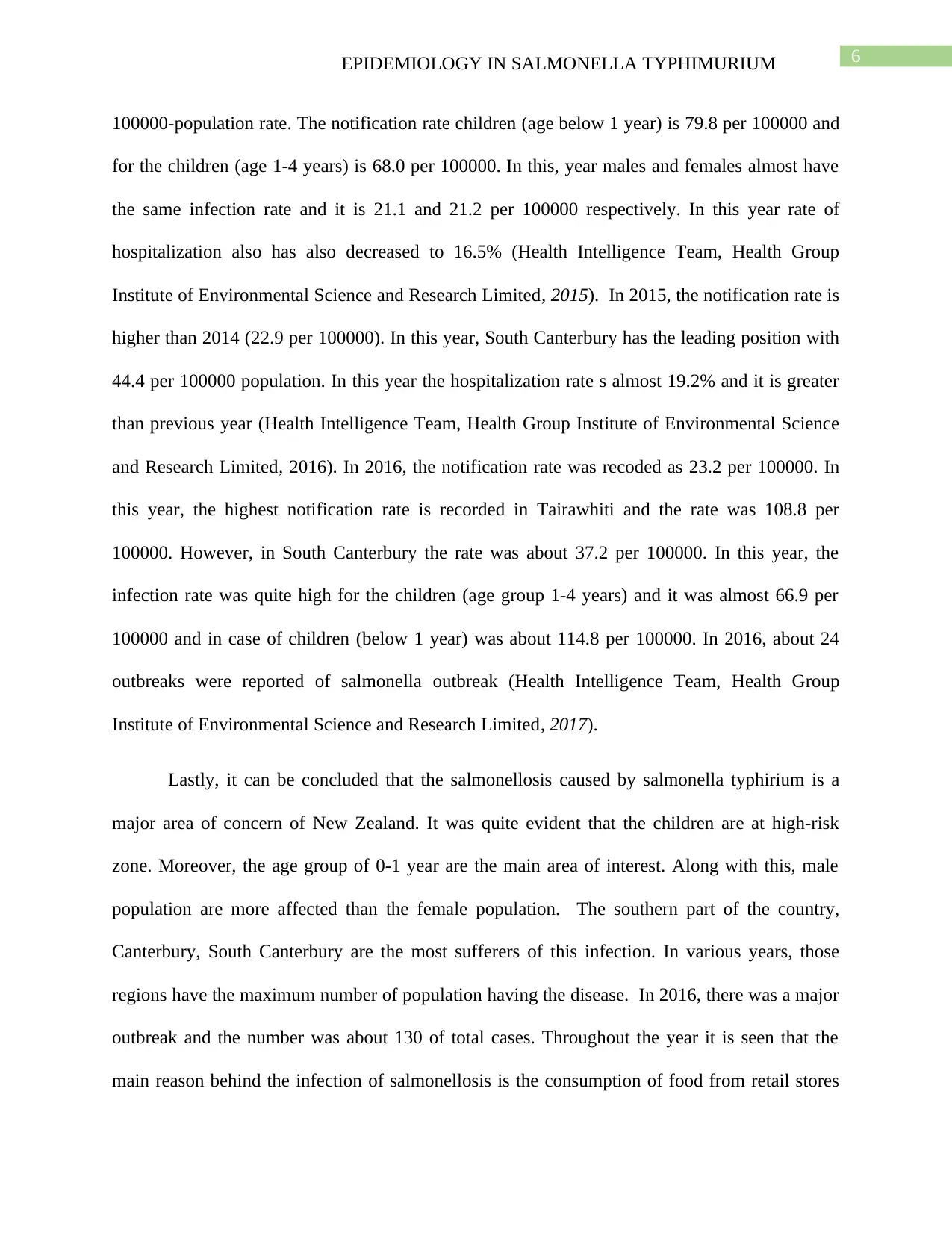
6EPIDEMIOLOGY IN SALMONELLA TYPHIMURIUM
100000-population rate. The notification rate children (age below 1 year) is 79.8 per 100000 and
for the children (age 1-4 years) is 68.0 per 100000. In this, year males and females almost have
the same infection rate and it is 21.1 and 21.2 per 100000 respectively. In this year rate of
hospitalization also has also decreased to 16.5% (Health Intelligence Team, Health Group
Institute of Environmental Science and Research Limited, 2015). In 2015, the notification rate is
higher than 2014 (22.9 per 100000). In this year, South Canterbury has the leading position with
44.4 per 100000 population. In this year the hospitalization rate s almost 19.2% and it is greater
than previous year (Health Intelligence Team, Health Group Institute of Environmental Science
and Research Limited, 2016). In 2016, the notification rate was recoded as 23.2 per 100000. In
this year, the highest notification rate is recorded in Tairawhiti and the rate was 108.8 per
100000. However, in South Canterbury the rate was about 37.2 per 100000. In this year, the
infection rate was quite high for the children (age group 1-4 years) and it was almost 66.9 per
100000 and in case of children (below 1 year) was about 114.8 per 100000. In 2016, about 24
outbreaks were reported of salmonella outbreak (Health Intelligence Team, Health Group
Institute of Environmental Science and Research Limited, 2017).
Lastly, it can be concluded that the salmonellosis caused by salmonella typhirium is a
major area of concern of New Zealand. It was quite evident that the children are at high-risk
zone. Moreover, the age group of 0-1 year are the main area of interest. Along with this, male
population are more affected than the female population. The southern part of the country,
Canterbury, South Canterbury are the most sufferers of this infection. In various years, those
regions have the maximum number of population having the disease. In 2016, there was a major
outbreak and the number was about 130 of total cases. Throughout the year it is seen that the
main reason behind the infection of salmonellosis is the consumption of food from retail stores
100000-population rate. The notification rate children (age below 1 year) is 79.8 per 100000 and
for the children (age 1-4 years) is 68.0 per 100000. In this, year males and females almost have
the same infection rate and it is 21.1 and 21.2 per 100000 respectively. In this year rate of
hospitalization also has also decreased to 16.5% (Health Intelligence Team, Health Group
Institute of Environmental Science and Research Limited, 2015). In 2015, the notification rate is
higher than 2014 (22.9 per 100000). In this year, South Canterbury has the leading position with
44.4 per 100000 population. In this year the hospitalization rate s almost 19.2% and it is greater
than previous year (Health Intelligence Team, Health Group Institute of Environmental Science
and Research Limited, 2016). In 2016, the notification rate was recoded as 23.2 per 100000. In
this year, the highest notification rate is recorded in Tairawhiti and the rate was 108.8 per
100000. However, in South Canterbury the rate was about 37.2 per 100000. In this year, the
infection rate was quite high for the children (age group 1-4 years) and it was almost 66.9 per
100000 and in case of children (below 1 year) was about 114.8 per 100000. In 2016, about 24
outbreaks were reported of salmonella outbreak (Health Intelligence Team, Health Group
Institute of Environmental Science and Research Limited, 2017).
Lastly, it can be concluded that the salmonellosis caused by salmonella typhirium is a
major area of concern of New Zealand. It was quite evident that the children are at high-risk
zone. Moreover, the age group of 0-1 year are the main area of interest. Along with this, male
population are more affected than the female population. The southern part of the country,
Canterbury, South Canterbury are the most sufferers of this infection. In various years, those
regions have the maximum number of population having the disease. In 2016, there was a major
outbreak and the number was about 130 of total cases. Throughout the year it is seen that the
main reason behind the infection of salmonellosis is the consumption of food from retail stores
Paraphrase This Document
Need a fresh take? Get an instant paraphrase of this document with our AI Paraphraser

7EPIDEMIOLOGY IN SALMONELLA TYPHIMURIUM
and as well as the drinking of untreated water. However, the rate of hospitalization was quite too
low in comparison with the rate of recorded cases of infection.
and as well as the drinking of untreated water. However, the rate of hospitalization was quite too
low in comparison with the rate of recorded cases of infection.
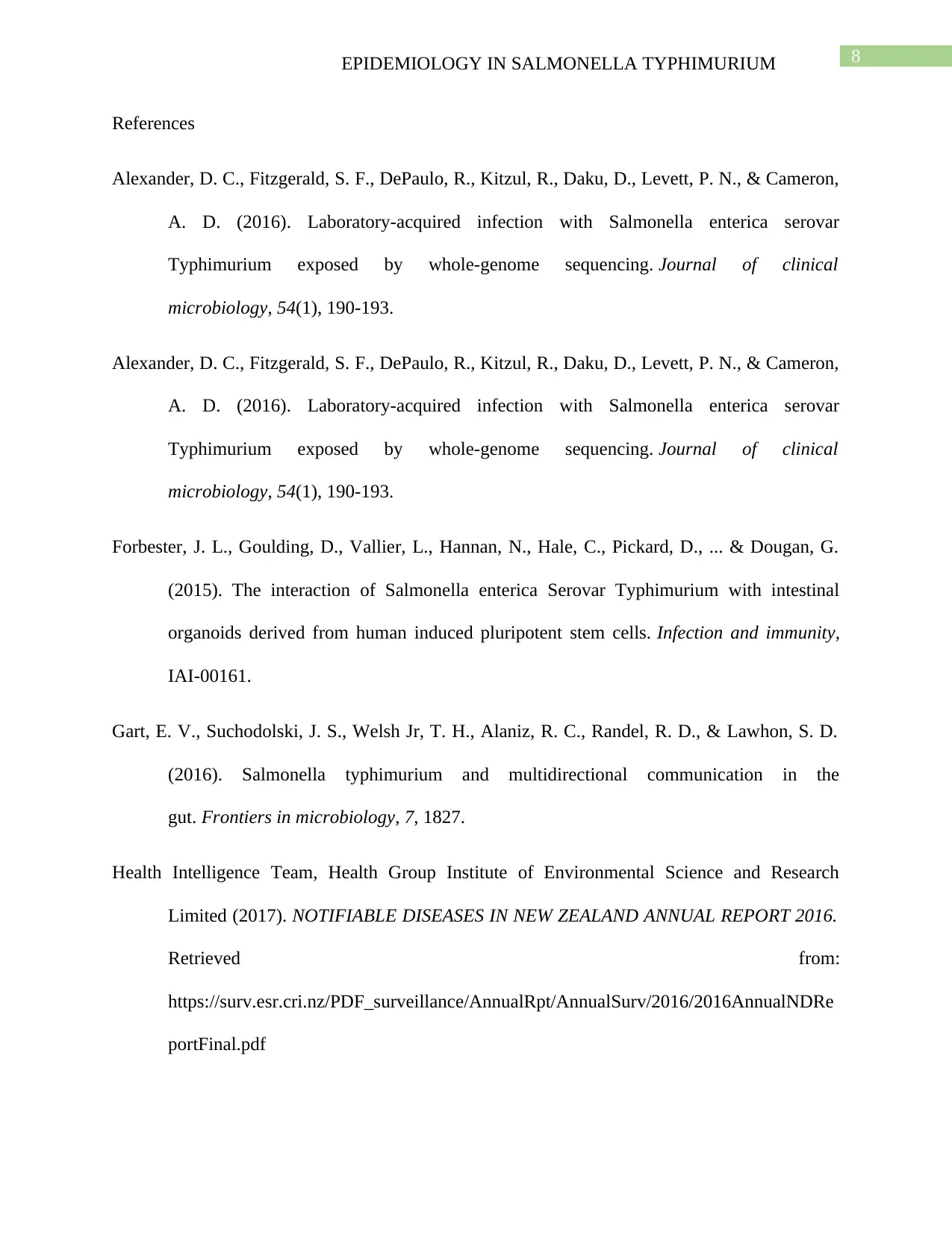
8EPIDEMIOLOGY IN SALMONELLA TYPHIMURIUM
References
Alexander, D. C., Fitzgerald, S. F., DePaulo, R., Kitzul, R., Daku, D., Levett, P. N., & Cameron,
A. D. (2016). Laboratory-acquired infection with Salmonella enterica serovar
Typhimurium exposed by whole-genome sequencing. Journal of clinical
microbiology, 54(1), 190-193.
Alexander, D. C., Fitzgerald, S. F., DePaulo, R., Kitzul, R., Daku, D., Levett, P. N., & Cameron,
A. D. (2016). Laboratory-acquired infection with Salmonella enterica serovar
Typhimurium exposed by whole-genome sequencing. Journal of clinical
microbiology, 54(1), 190-193.
Forbester, J. L., Goulding, D., Vallier, L., Hannan, N., Hale, C., Pickard, D., ... & Dougan, G.
(2015). The interaction of Salmonella enterica Serovar Typhimurium with intestinal
organoids derived from human induced pluripotent stem cells. Infection and immunity,
IAI-00161.
Gart, E. V., Suchodolski, J. S., Welsh Jr, T. H., Alaniz, R. C., Randel, R. D., & Lawhon, S. D.
(2016). Salmonella typhimurium and multidirectional communication in the
gut. Frontiers in microbiology, 7, 1827.
Health Intelligence Team, Health Group Institute of Environmental Science and Research
Limited (2017). NOTIFIABLE DISEASES IN NEW ZEALAND ANNUAL REPORT 2016.
Retrieved from:
https://surv.esr.cri.nz/PDF_surveillance/AnnualRpt/AnnualSurv/2016/2016AnnualNDRe
portFinal.pdf
References
Alexander, D. C., Fitzgerald, S. F., DePaulo, R., Kitzul, R., Daku, D., Levett, P. N., & Cameron,
A. D. (2016). Laboratory-acquired infection with Salmonella enterica serovar
Typhimurium exposed by whole-genome sequencing. Journal of clinical
microbiology, 54(1), 190-193.
Alexander, D. C., Fitzgerald, S. F., DePaulo, R., Kitzul, R., Daku, D., Levett, P. N., & Cameron,
A. D. (2016). Laboratory-acquired infection with Salmonella enterica serovar
Typhimurium exposed by whole-genome sequencing. Journal of clinical
microbiology, 54(1), 190-193.
Forbester, J. L., Goulding, D., Vallier, L., Hannan, N., Hale, C., Pickard, D., ... & Dougan, G.
(2015). The interaction of Salmonella enterica Serovar Typhimurium with intestinal
organoids derived from human induced pluripotent stem cells. Infection and immunity,
IAI-00161.
Gart, E. V., Suchodolski, J. S., Welsh Jr, T. H., Alaniz, R. C., Randel, R. D., & Lawhon, S. D.
(2016). Salmonella typhimurium and multidirectional communication in the
gut. Frontiers in microbiology, 7, 1827.
Health Intelligence Team, Health Group Institute of Environmental Science and Research
Limited (2017). NOTIFIABLE DISEASES IN NEW ZEALAND ANNUAL REPORT 2016.
Retrieved from:
https://surv.esr.cri.nz/PDF_surveillance/AnnualRpt/AnnualSurv/2016/2016AnnualNDRe
portFinal.pdf
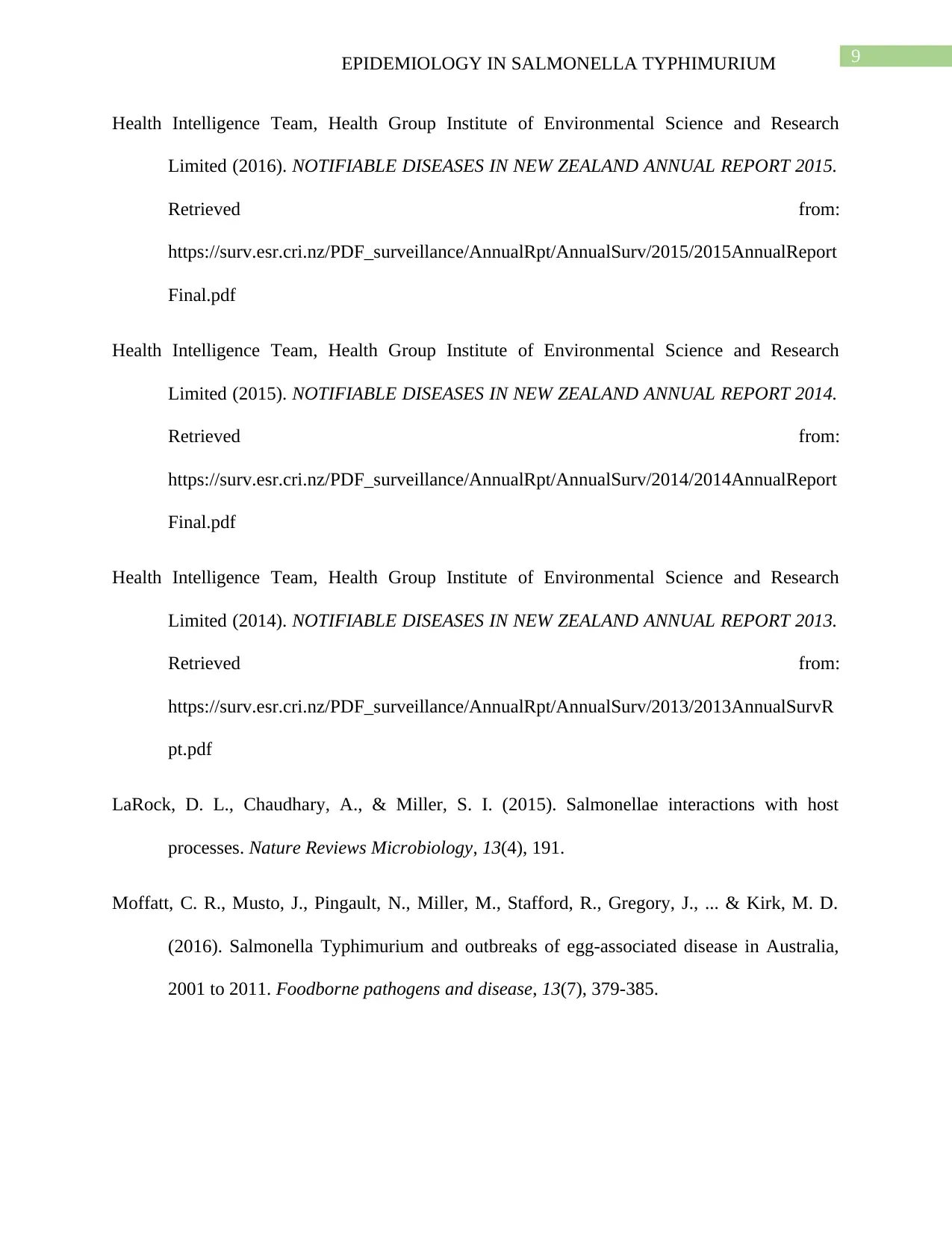
9EPIDEMIOLOGY IN SALMONELLA TYPHIMURIUM
Health Intelligence Team, Health Group Institute of Environmental Science and Research
Limited (2016). NOTIFIABLE DISEASES IN NEW ZEALAND ANNUAL REPORT 2015.
Retrieved from:
https://surv.esr.cri.nz/PDF_surveillance/AnnualRpt/AnnualSurv/2015/2015AnnualReport
Final.pdf
Health Intelligence Team, Health Group Institute of Environmental Science and Research
Limited (2015). NOTIFIABLE DISEASES IN NEW ZEALAND ANNUAL REPORT 2014.
Retrieved from:
https://surv.esr.cri.nz/PDF_surveillance/AnnualRpt/AnnualSurv/2014/2014AnnualReport
Final.pdf
Health Intelligence Team, Health Group Institute of Environmental Science and Research
Limited (2014). NOTIFIABLE DISEASES IN NEW ZEALAND ANNUAL REPORT 2013.
Retrieved from:
https://surv.esr.cri.nz/PDF_surveillance/AnnualRpt/AnnualSurv/2013/2013AnnualSurvR
pt.pdf
LaRock, D. L., Chaudhary, A., & Miller, S. I. (2015). Salmonellae interactions with host
processes. Nature Reviews Microbiology, 13(4), 191.
Moffatt, C. R., Musto, J., Pingault, N., Miller, M., Stafford, R., Gregory, J., ... & Kirk, M. D.
(2016). Salmonella Typhimurium and outbreaks of egg-associated disease in Australia,
2001 to 2011. Foodborne pathogens and disease, 13(7), 379-385.
Health Intelligence Team, Health Group Institute of Environmental Science and Research
Limited (2016). NOTIFIABLE DISEASES IN NEW ZEALAND ANNUAL REPORT 2015.
Retrieved from:
https://surv.esr.cri.nz/PDF_surveillance/AnnualRpt/AnnualSurv/2015/2015AnnualReport
Final.pdf
Health Intelligence Team, Health Group Institute of Environmental Science and Research
Limited (2015). NOTIFIABLE DISEASES IN NEW ZEALAND ANNUAL REPORT 2014.
Retrieved from:
https://surv.esr.cri.nz/PDF_surveillance/AnnualRpt/AnnualSurv/2014/2014AnnualReport
Final.pdf
Health Intelligence Team, Health Group Institute of Environmental Science and Research
Limited (2014). NOTIFIABLE DISEASES IN NEW ZEALAND ANNUAL REPORT 2013.
Retrieved from:
https://surv.esr.cri.nz/PDF_surveillance/AnnualRpt/AnnualSurv/2013/2013AnnualSurvR
pt.pdf
LaRock, D. L., Chaudhary, A., & Miller, S. I. (2015). Salmonellae interactions with host
processes. Nature Reviews Microbiology, 13(4), 191.
Moffatt, C. R., Musto, J., Pingault, N., Miller, M., Stafford, R., Gregory, J., ... & Kirk, M. D.
(2016). Salmonella Typhimurium and outbreaks of egg-associated disease in Australia,
2001 to 2011. Foodborne pathogens and disease, 13(7), 379-385.
Secure Best Marks with AI Grader
Need help grading? Try our AI Grader for instant feedback on your assignments.
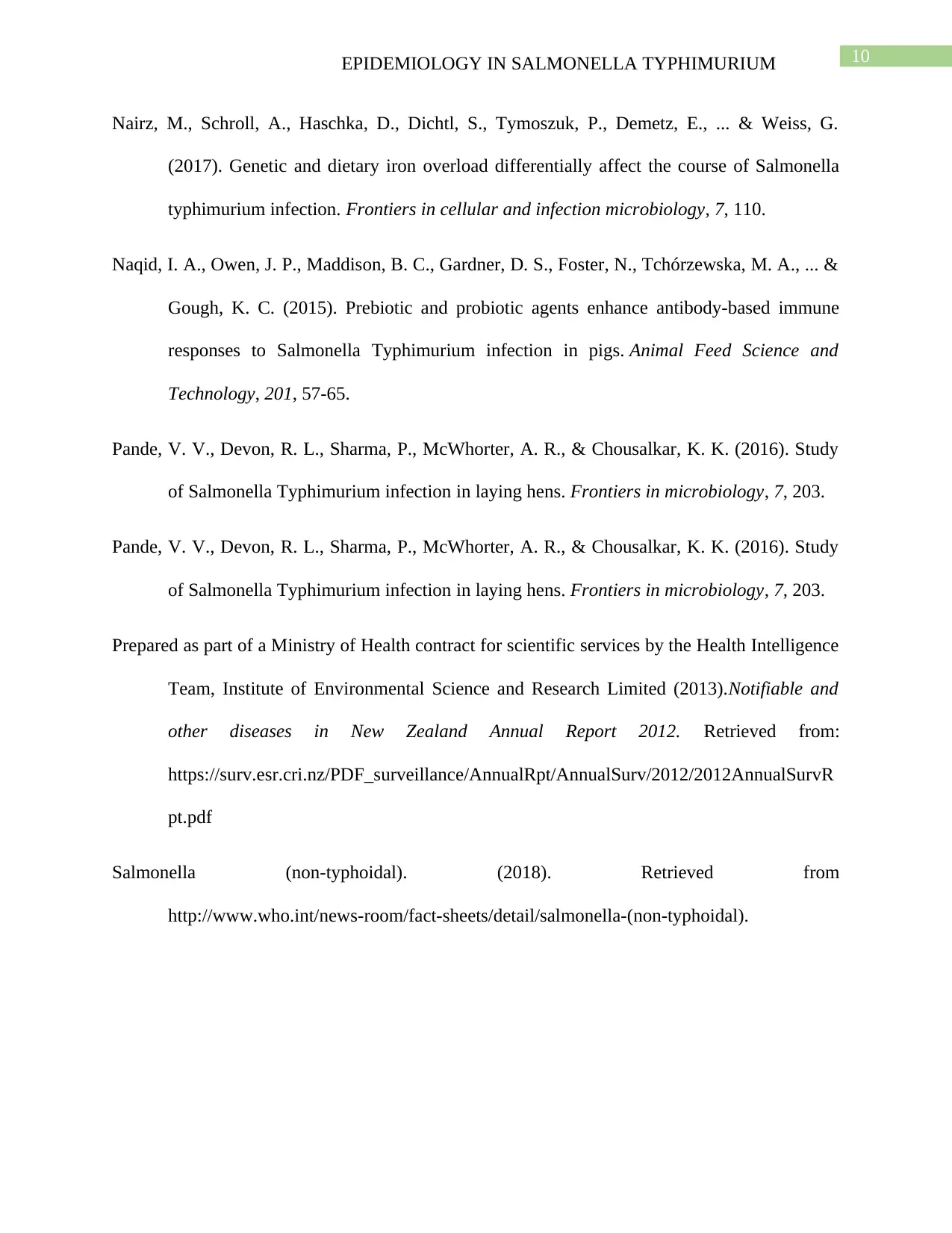
10EPIDEMIOLOGY IN SALMONELLA TYPHIMURIUM
Nairz, M., Schroll, A., Haschka, D., Dichtl, S., Tymoszuk, P., Demetz, E., ... & Weiss, G.
(2017). Genetic and dietary iron overload differentially affect the course of Salmonella
typhimurium infection. Frontiers in cellular and infection microbiology, 7, 110.
Naqid, I. A., Owen, J. P., Maddison, B. C., Gardner, D. S., Foster, N., Tchórzewska, M. A., ... &
Gough, K. C. (2015). Prebiotic and probiotic agents enhance antibody-based immune
responses to Salmonella Typhimurium infection in pigs. Animal Feed Science and
Technology, 201, 57-65.
Pande, V. V., Devon, R. L., Sharma, P., McWhorter, A. R., & Chousalkar, K. K. (2016). Study
of Salmonella Typhimurium infection in laying hens. Frontiers in microbiology, 7, 203.
Pande, V. V., Devon, R. L., Sharma, P., McWhorter, A. R., & Chousalkar, K. K. (2016). Study
of Salmonella Typhimurium infection in laying hens. Frontiers in microbiology, 7, 203.
Prepared as part of a Ministry of Health contract for scientific services by the Health Intelligence
Team, Institute of Environmental Science and Research Limited (2013).Notifiable and
other diseases in New Zealand Annual Report 2012. Retrieved from:
https://surv.esr.cri.nz/PDF_surveillance/AnnualRpt/AnnualSurv/2012/2012AnnualSurvR
pt.pdf
Salmonella (non-typhoidal). (2018). Retrieved from
http://www.who.int/news-room/fact-sheets/detail/salmonella-(non-typhoidal).
Nairz, M., Schroll, A., Haschka, D., Dichtl, S., Tymoszuk, P., Demetz, E., ... & Weiss, G.
(2017). Genetic and dietary iron overload differentially affect the course of Salmonella
typhimurium infection. Frontiers in cellular and infection microbiology, 7, 110.
Naqid, I. A., Owen, J. P., Maddison, B. C., Gardner, D. S., Foster, N., Tchórzewska, M. A., ... &
Gough, K. C. (2015). Prebiotic and probiotic agents enhance antibody-based immune
responses to Salmonella Typhimurium infection in pigs. Animal Feed Science and
Technology, 201, 57-65.
Pande, V. V., Devon, R. L., Sharma, P., McWhorter, A. R., & Chousalkar, K. K. (2016). Study
of Salmonella Typhimurium infection in laying hens. Frontiers in microbiology, 7, 203.
Pande, V. V., Devon, R. L., Sharma, P., McWhorter, A. R., & Chousalkar, K. K. (2016). Study
of Salmonella Typhimurium infection in laying hens. Frontiers in microbiology, 7, 203.
Prepared as part of a Ministry of Health contract for scientific services by the Health Intelligence
Team, Institute of Environmental Science and Research Limited (2013).Notifiable and
other diseases in New Zealand Annual Report 2012. Retrieved from:
https://surv.esr.cri.nz/PDF_surveillance/AnnualRpt/AnnualSurv/2012/2012AnnualSurvR
pt.pdf
Salmonella (non-typhoidal). (2018). Retrieved from
http://www.who.int/news-room/fact-sheets/detail/salmonella-(non-typhoidal).
1 out of 11
Related Documents
Your All-in-One AI-Powered Toolkit for Academic Success.
+13062052269
info@desklib.com
Available 24*7 on WhatsApp / Email
![[object Object]](/_next/static/media/star-bottom.7253800d.svg)
Unlock your academic potential
© 2024 | Zucol Services PVT LTD | All rights reserved.





